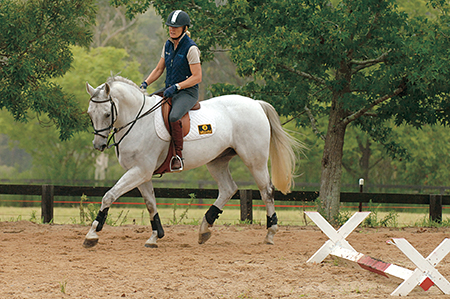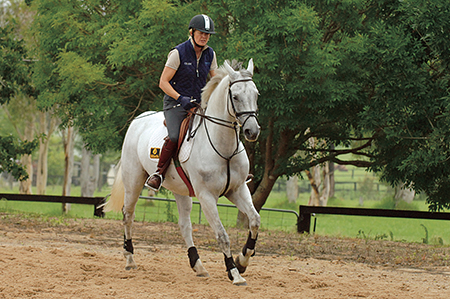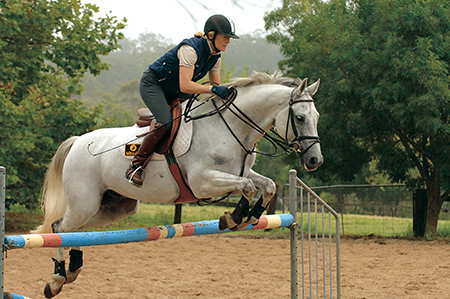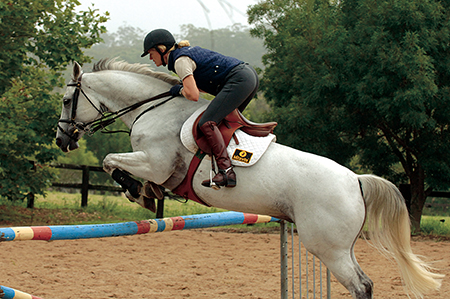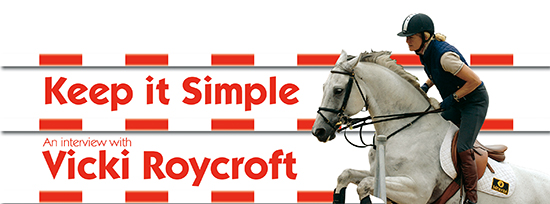 One of the problems about writing about training horses is that the brilliant trainers don’t have any gimmicks or magic tricks – just good clean training. The wizards with the wands make for far more entertaining reading but the problem is that they never seem to produce it where it matters – in the competition arena.
One of the problems about writing about training horses is that the brilliant trainers don’t have any gimmicks or magic tricks – just good clean training. The wizards with the wands make for far more entertaining reading but the problem is that they never seem to produce it where it matters – in the competition arena.
Vicki Roycroft has certainly produced it when it counts. The winner of countless World Cup classes, the current Australian Champion with Ricardo D, has produced stunning performances in Australia and in Europe, where she was in the top ten at the first WEG, and took out the prestigious Grand Prix of Rome.
Right now, Vicki has one of her strongest teams of horses ever; it is also probably one of the diverse – ranging from the huge 17+ ‘Irish’ (Infatuation), to the diminutive Ricci (Ricardo D) to the spectacularly coloured stallion, Copabella Visage.
But despite the wide variety of type, shape and colour – the training is basically pretty simple – because after all, the animal we are dealing with is also kind of simple..
“Why do we assume that horses are intelligent?” Vicki asks. “They are not as smart as dogs – you might be able to teach one to come, but try to teach him to sit! That to me is one of the huge problems, people assume that horses have an intelligence they don’t have. They have personalities, enormous personalities, but they don’t have the intelligence of a dog. Any training you do with a horse has to be based on the assumption that they are not very intelligent and you have to keep everything very clear and simple.”
“All my work regimes are similar – simple, very clear exercises. All my training is inspired by Wayne and Bill Roycroft, and then George Morris. But it’s not just them, Albert Voorn had that philosophy of keeping it simple – put one leg on them and they move one way, put the other on and they move the other way. You can put all the fancy names on the exercises, but it is still basically the same exercise because you are teaching your horses to react to the aids. Keep it simple.”
What proportion of the work is gymnastic fittening work as distinct from learning work?
“Most of it is gymnastic fitness work but you are teaching them at the same time, reminding them to react to the aids. In any of your work you’ve got to expect resistance – obviously more from a young horse – they’d all rather be sitting in a paddock eating grass. It’s all right for us to go out and do aerobics and gymnastics, we want to make our bodies more beautiful or whatever – but horses don’t have incentives like that. They have no incentive to train, that’s why all this crap about the ‘happy athlete’ is so crazy.”
“A happy horse is a horse that knows what is expected of it. They have a very simple thought process: if they are getting fed at regular times, if they know what to expect in their work, they are happy enough – but if you have horses that don’t know what they are supposed to do, because the riders are not consistent, then you have problems.”
“You have to be consistent, the horse walks forward and it is on the bit – not one minute off the bit, and then the next minute the rider suddenly decides it has to be on the bit, it’s not allowed to poke its nose. That makes the horse unhappy because it is confused. As a rider you have to be consistent totally to create something like a happy horse.”
How fit does a jumper have to be? The eventers obviously think a lot about fitness – do showjumping riders?
“The level of fitness varies. For a normal jumper it is not a very high level. My horses get 20 minutes every day – very seldom less or more. If I am aiming for a bigger event, like a Games or a five star show, then okay I’ll step the fitness up another level. If they’ve got to do a Nations Cup, or a serious championship, then they will go to 30 or 40 minutes work a day. And I’d give them a little more strong canter work to step it up to the 400 metres per minute.”
And they go out in the paddock during the day?
“All my horses go out except for Ricci because he gets too fat – he is allowed two hours on grass a day! Irish is out there all the time because it keeps him more mentally happy. The stallions come in at night but they go in the paddock all day. Outside is a natural environment for a horse, it keeps them more comfortable, it prolongs their careers.”
“Obviously you have to watch what you feed them. I’ve never been one to not feed some sort of protein – even to the hottest horse. Oddly enough, the very hot Thoroughbred I had, Apache, he was better off on a lot of grain. In his case because he was a little horse, because he was strong and healthy with a lot of grain, he was actually easier to ride. I think it is like people with poor nutrition, they end up tired and cranky… I’ve never been one to feed horses just chaff and hay and nothing else. Now I’ve got Irish, he is 18 hands with the brain of a hot Thoroughbred; he’s a very difficult horse. I don’t feed him a lot of grain, he gets the Mitavite Pro-sport, and that suits him very well. Whereas someone like Ricci who is a bit phlegmatic and needs to be very fit and strong – I actually work him a bit harder than the others – and he gets the more oat based feeds – like Sustain – to keep him there. You’ve got to tailor everything, feed, fitness programs, to fit the individual horse. They have to be healthy and feeling great, they are athletes, they’ve got to feel like they can do the job, they can fight to win.”
How much is suppling part of that?
“Essential because that is the nature of modern course designing – they are always asking you to run forward and sit back, to be able to do a bending six or a direct five… I was watching Fox channel on showjumping at Spruce Meadows the other day, and there was an open water, five long strides to a big oxer, then what looked like it would have stepped a nice six or a steady seven, but you had to do eight up to a double of verticals – the Athens Coins fences which are very hard to see – so not only did you have to add one stride but you had to add two to get the horses sitting on their hocks. It has become a much more technical sport, which I think is a good thing because it then shows how well the rider can ride and train the horse, not just how much jumping ability the horse has.”
Does that mean you’ve got to move to another level of sophistication in your flat work?
“Sure, but that has been an increasing factor over the years, no question.”
How sophisticated does it have to be?
“That’s where I go back to the simplicity of someone like Albert Voorn who said, ‘I never do half passes’. We don’t necessarily have to do half passes, but you do need a horse that understands an inside and an outside leg. I guess when they go in the dressage arena, they ride a half pass to prove that, but for us, the proof is in the ring, how well they handle the lines, how well you have trained them to respond to that inside leg and outside rein. I do a lot of lateral work, but mainly leg yield.”
“I do quite a lot of counter canter because it is so good for their balance. It’s jumping flatwork. I don’t know how much it varies from straight dressage but for instance, in the rein back I don’t like horses to rein back and then go straight forwards because to me, that looks like the clashing of aids. I’d rather they back up and stop, chill out and then go forward again. I wonder sometimes if that is why you see so many lousy rein backs at dressage competitions.”
“It’s the same basic principles, just varied to suit the different disciplines.”
In this keep it simple mode, do you keep what is in their mouth simple, or do you change that around?
“Bits don’t make a huge difference. Bits can refine and give you that little extra help but we are talking about a very small percentage – if you think a bit can totally change a horse, it won’t. It can refine the process but it won’t solve the problem.”
The rest of the auxiliaries – like draw reins? After all it was the showjumpers who created this whole ‘rollkur’ problem in dressage with Alwin Schockemöhle riding them super deep and round in draw reins…
“I love the deep riding but riding deep and reaching. I haven’t entirely followed the dressage debate but I entirely agree with your comments. I was in Athens – how could you give the gold to a horse that won’t even stop? It wouldn’t stand when she went to get back on it, it took four people to hold it – and then it jacks up when she goes for the presentation. That was the single most noble gesture at the Games, when Ulla (Salzgeber and Rusty) gave Anky (Van Grunsven and Salinero) a lead to do the presentation. It was rearing and jacking up and spinning sideways. We all just sat and waited and after about three minutes Ulla finally gave her a lead… I wouldn’t have done it, I’d have backed up a couple of paces. What kind of dressage horse is that?”
“I used draw reins a couple of times when I first got Ricci and he was a total plank. He’d spent a year in the States with a little American junior, and he was a total plank – but that is the only time in the last six or seven years I’ve used them.”
But you want them deep and over the back?
“In the training I think that is essential – again this is another difference from dressage, I want a very supple loose neck. All the horses I’ve got from dressage or eventing people that come here to make jumpers, the first thing I notice is the rigid neck. In the dressage arena they obviously demand this stillness and they are just rigid in the neck – I’m sure that doesn’t apply at the top level. As showjumpers, one of the things is that the neck has to be very supple because that allows the shoulders to be supple and the horse jumps bigger.”
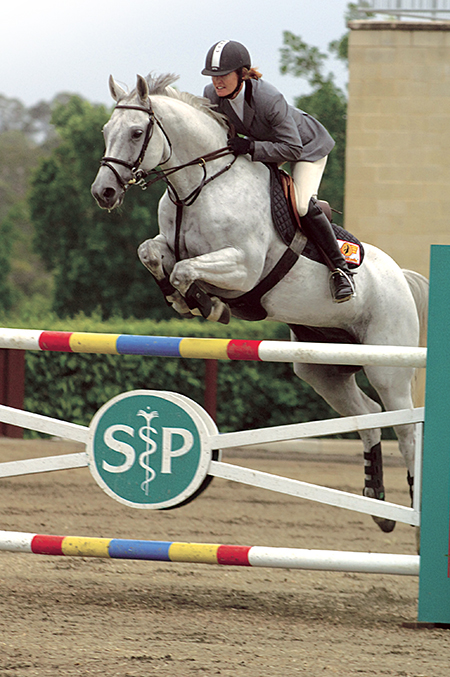 This article was first published in THM April 2006.
This article was first published in THM April 2006.

